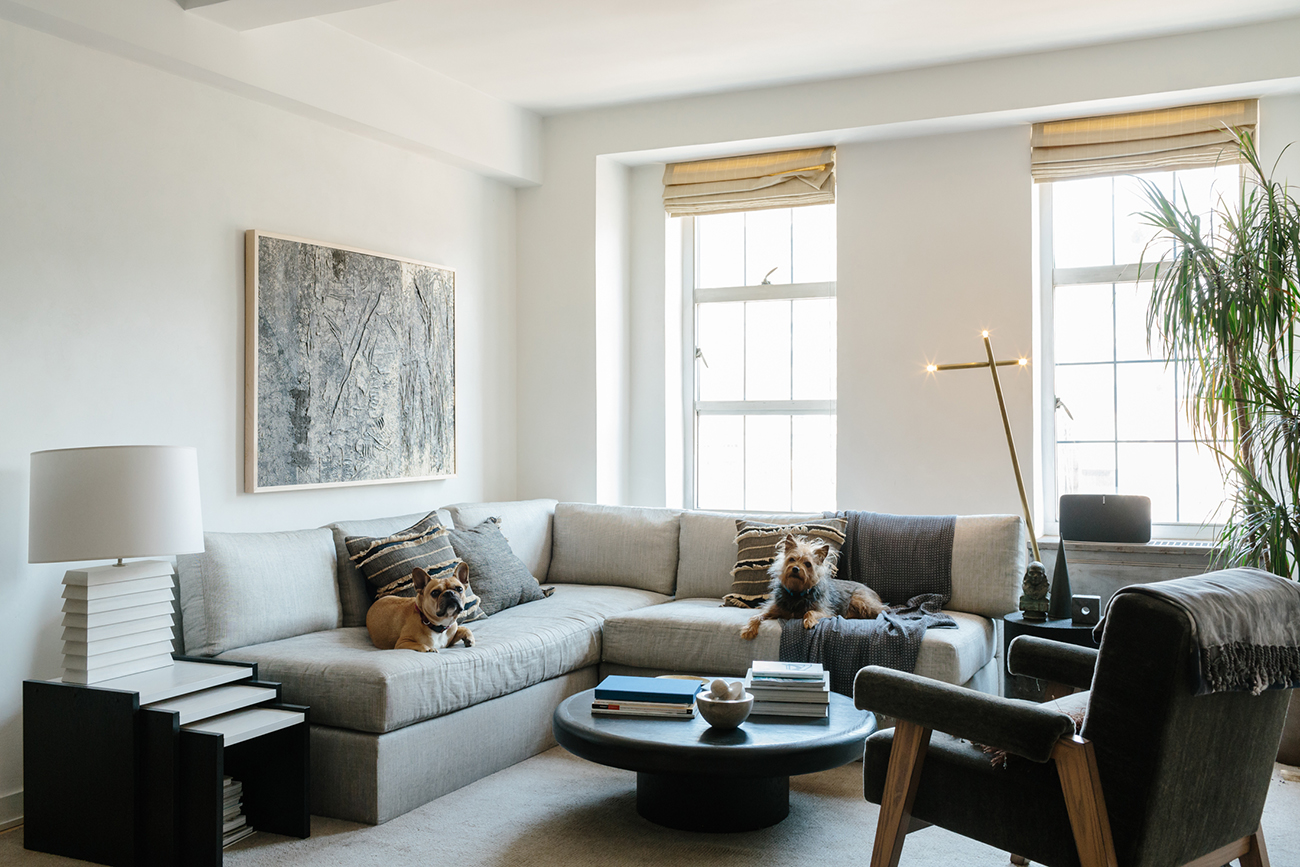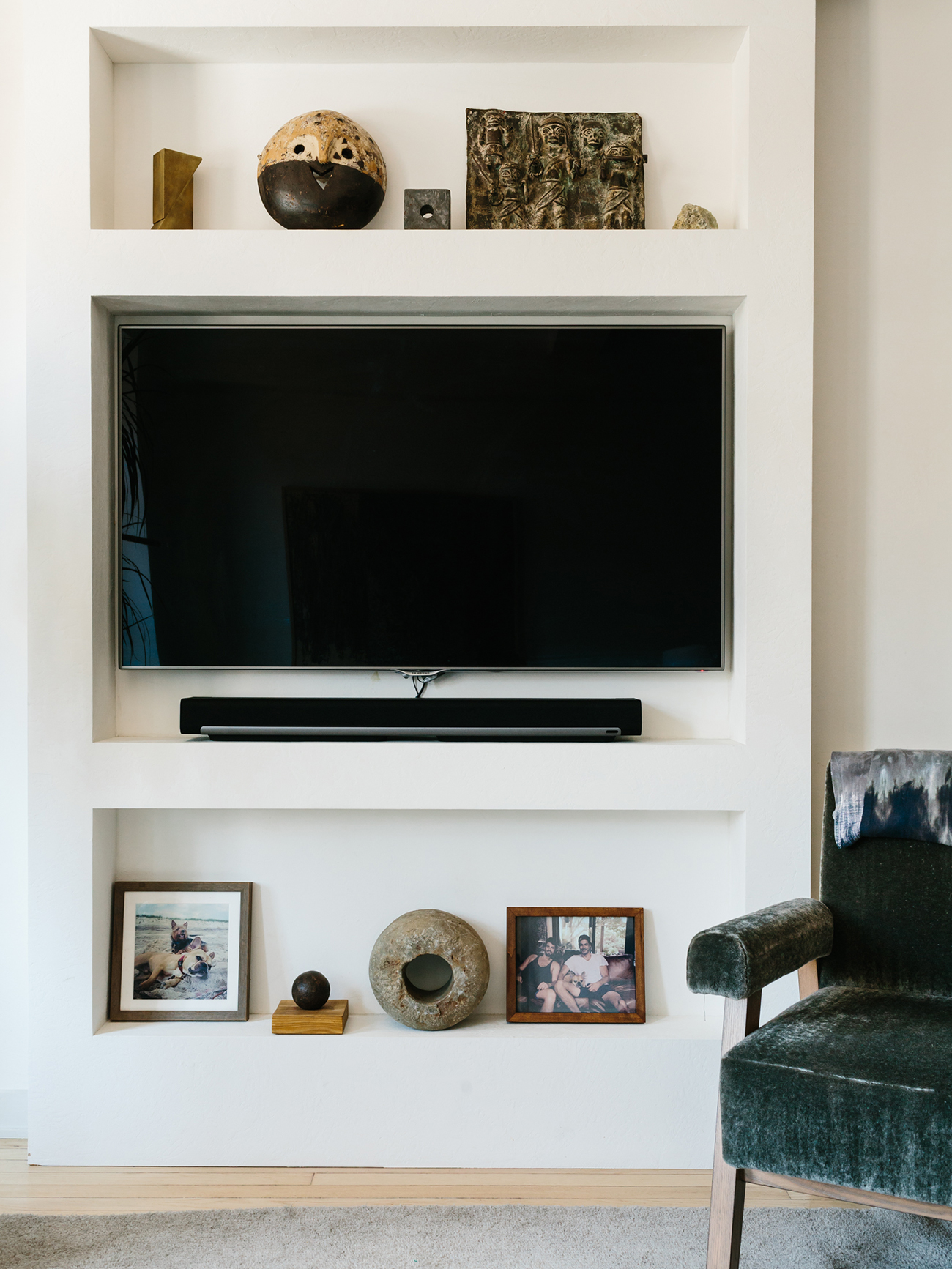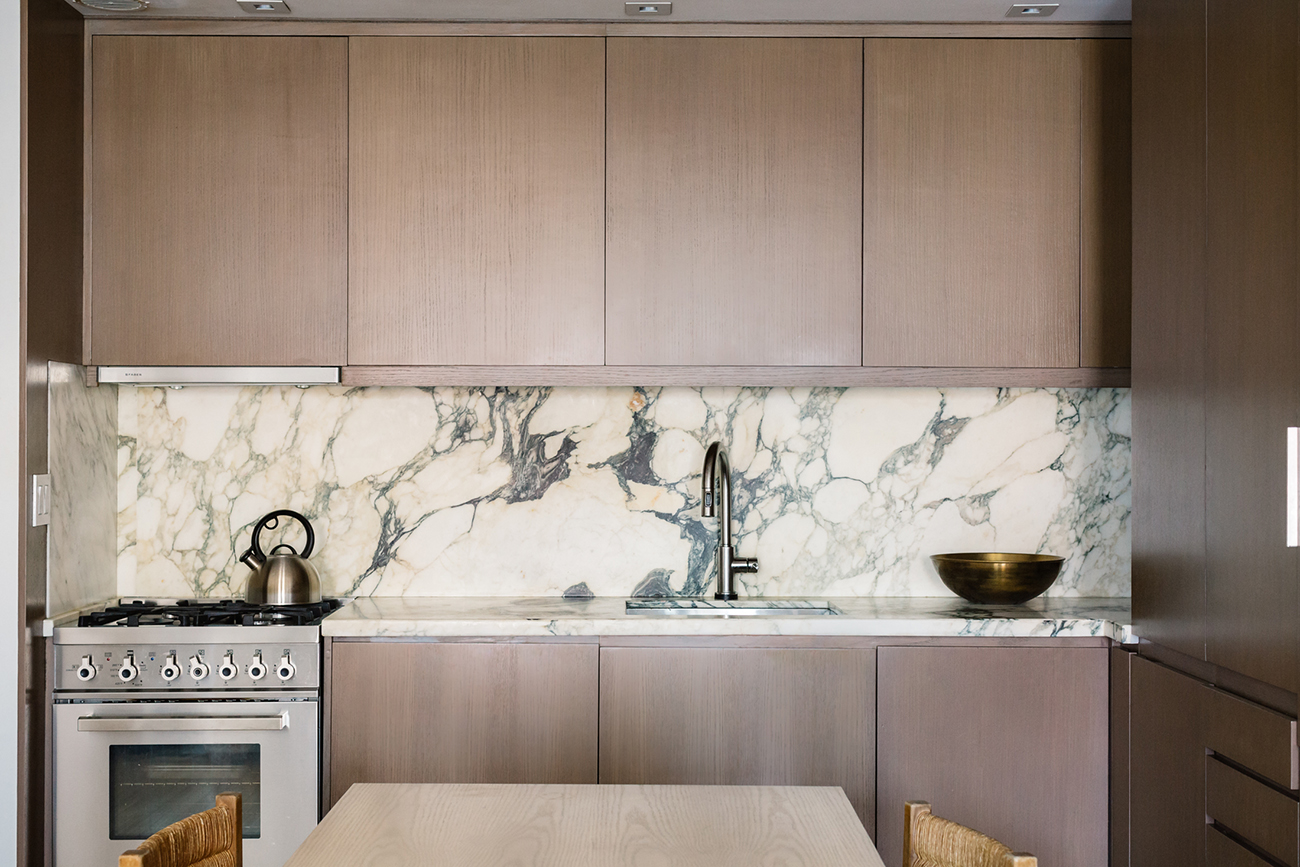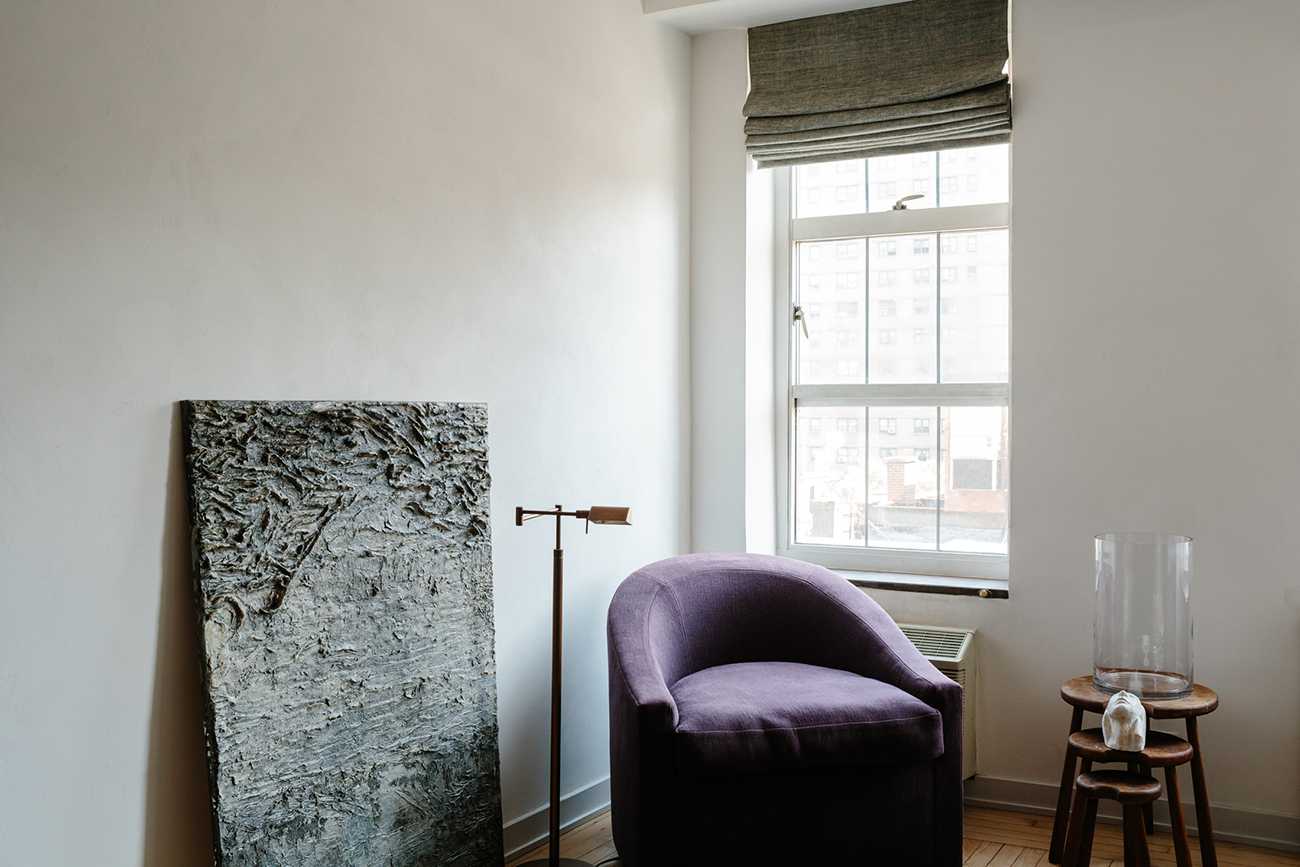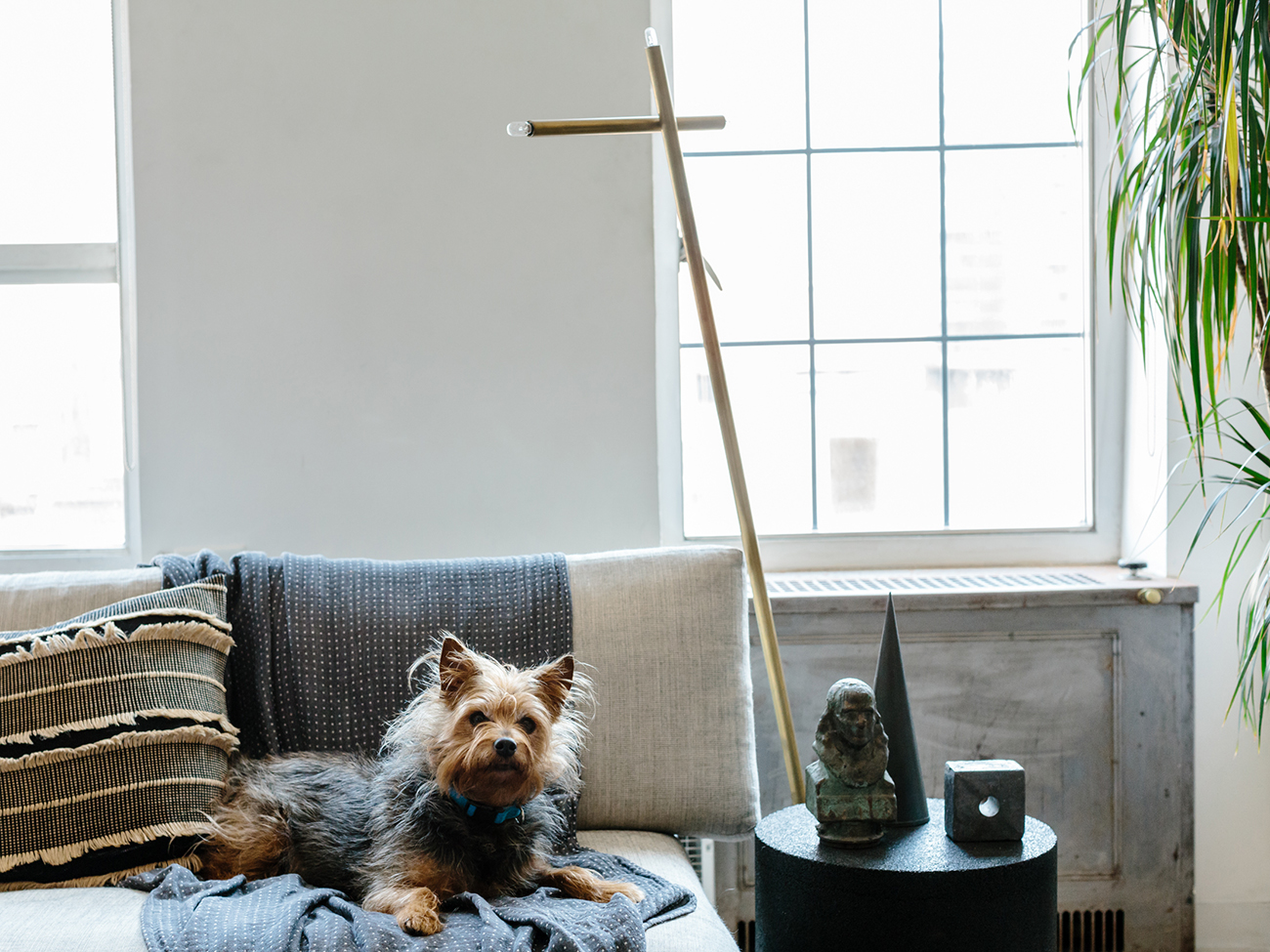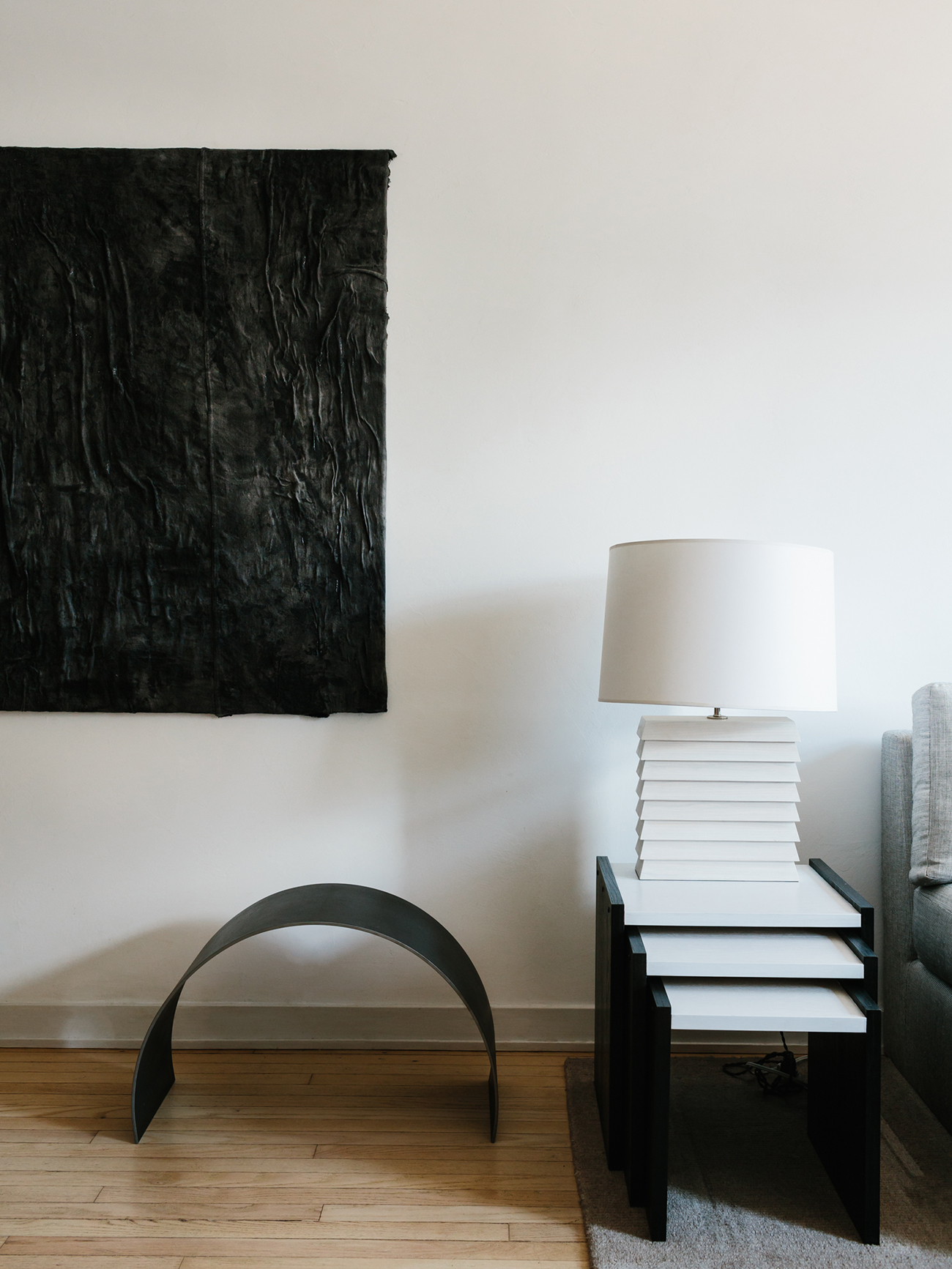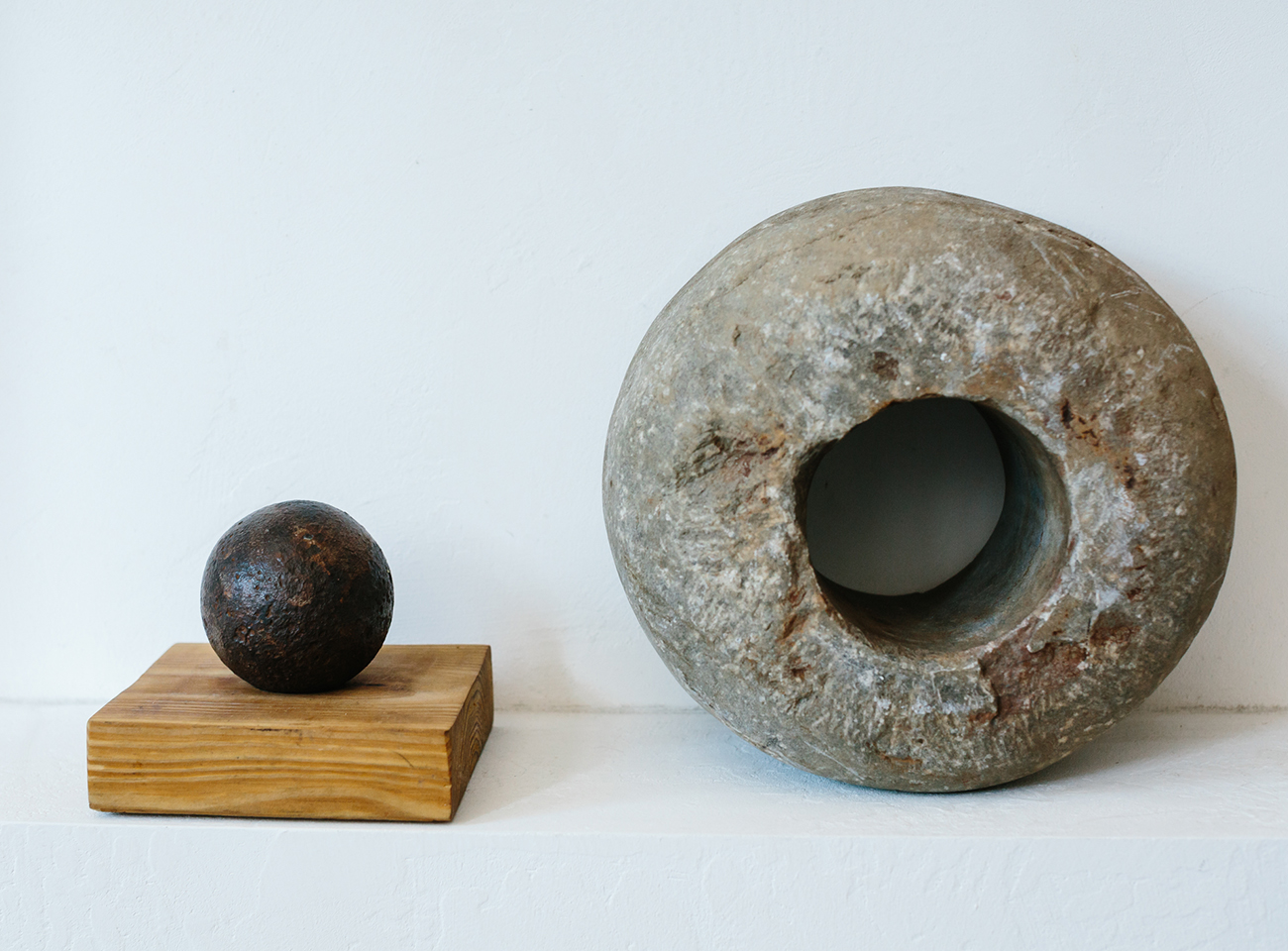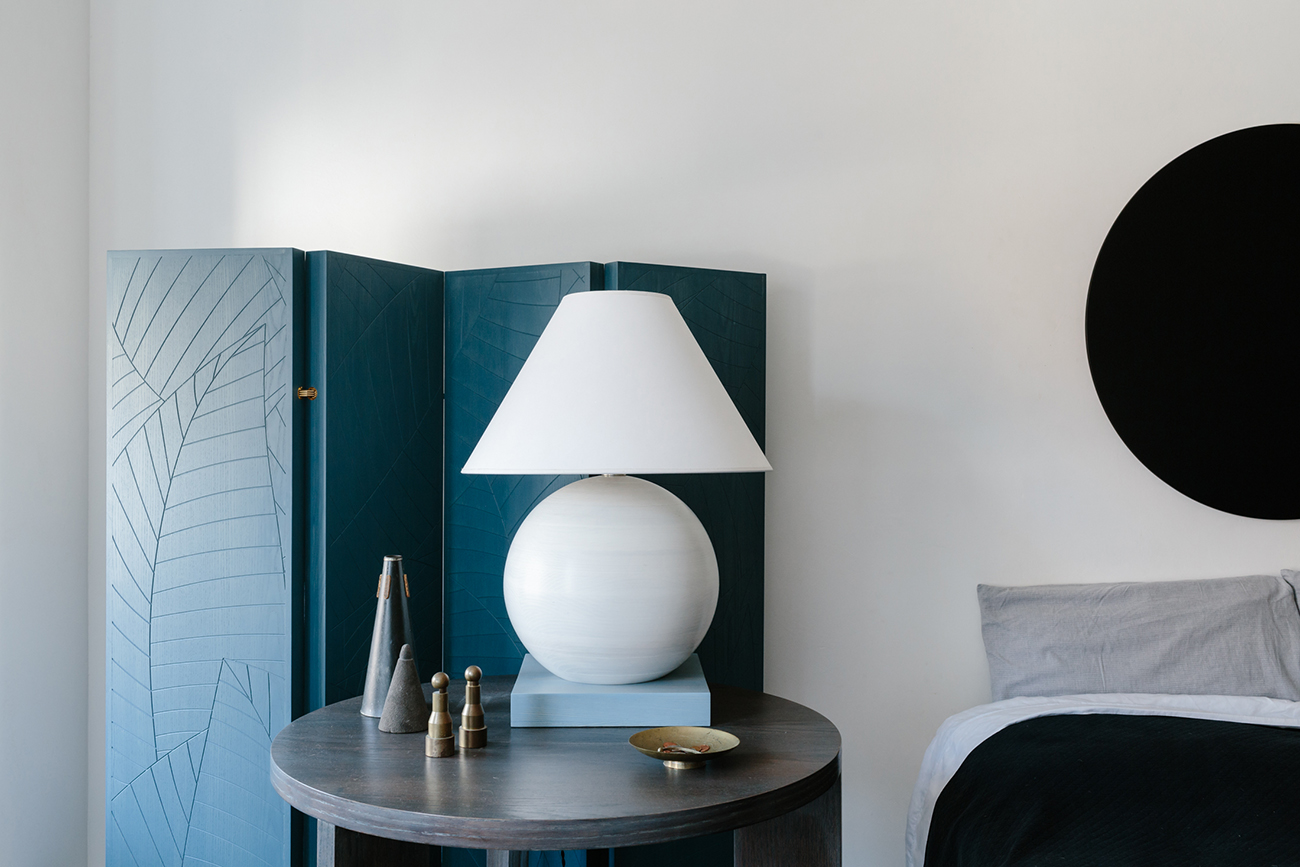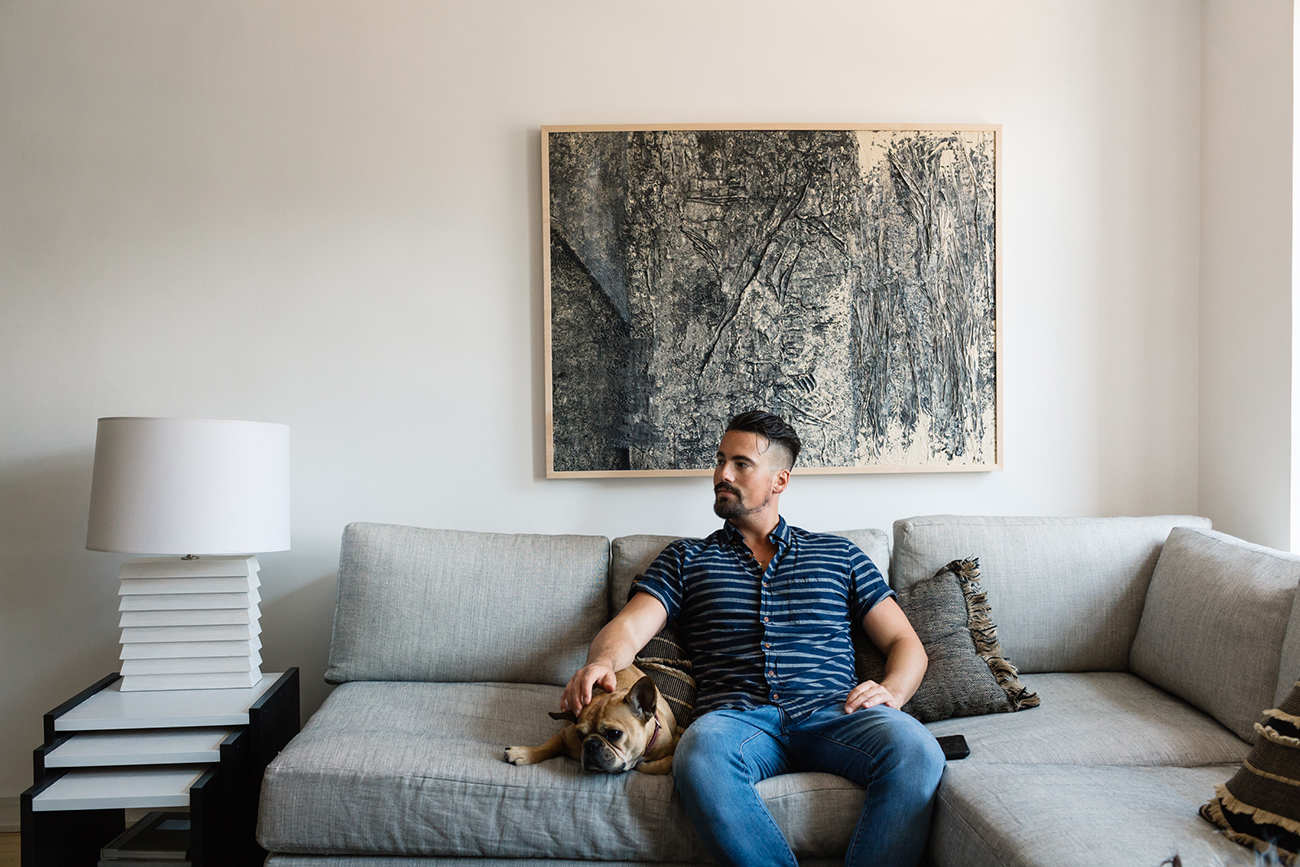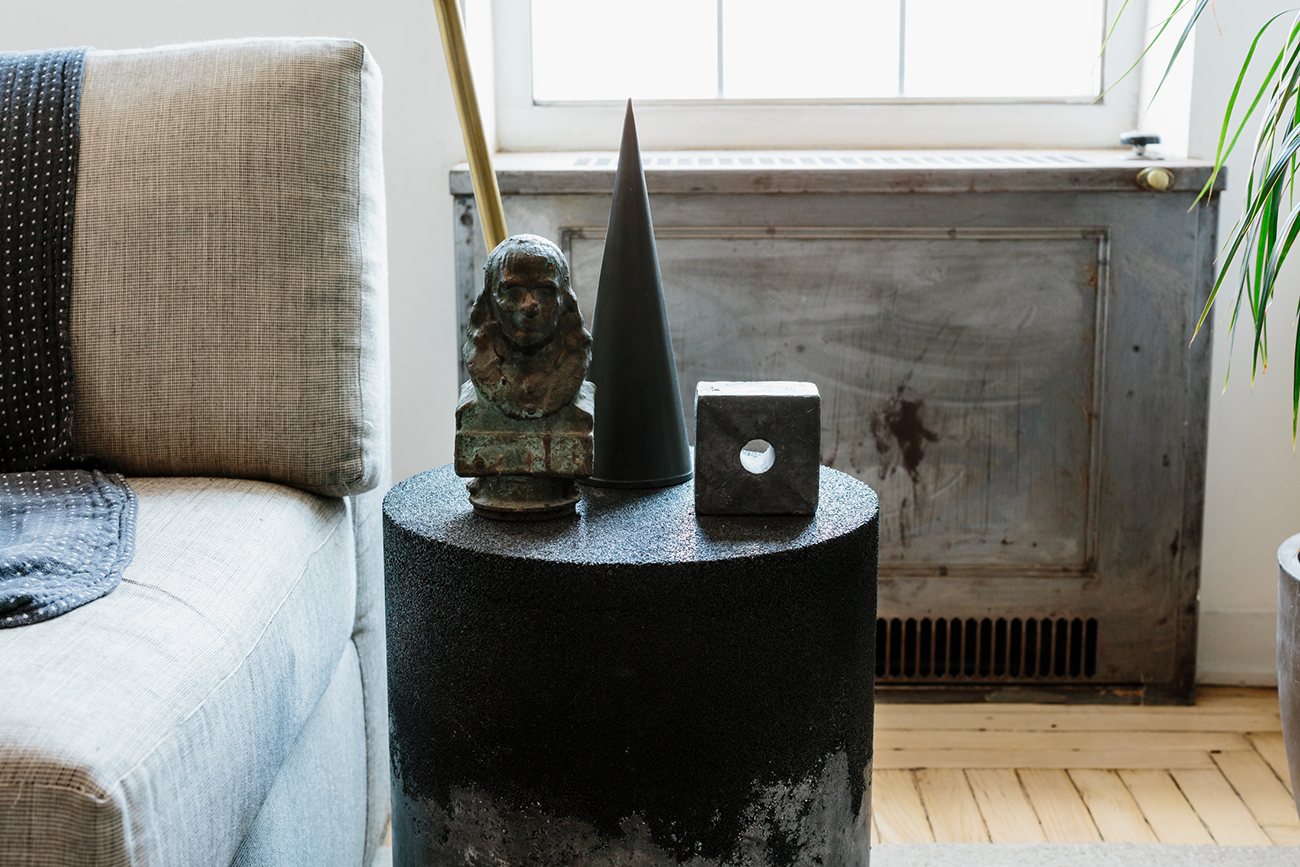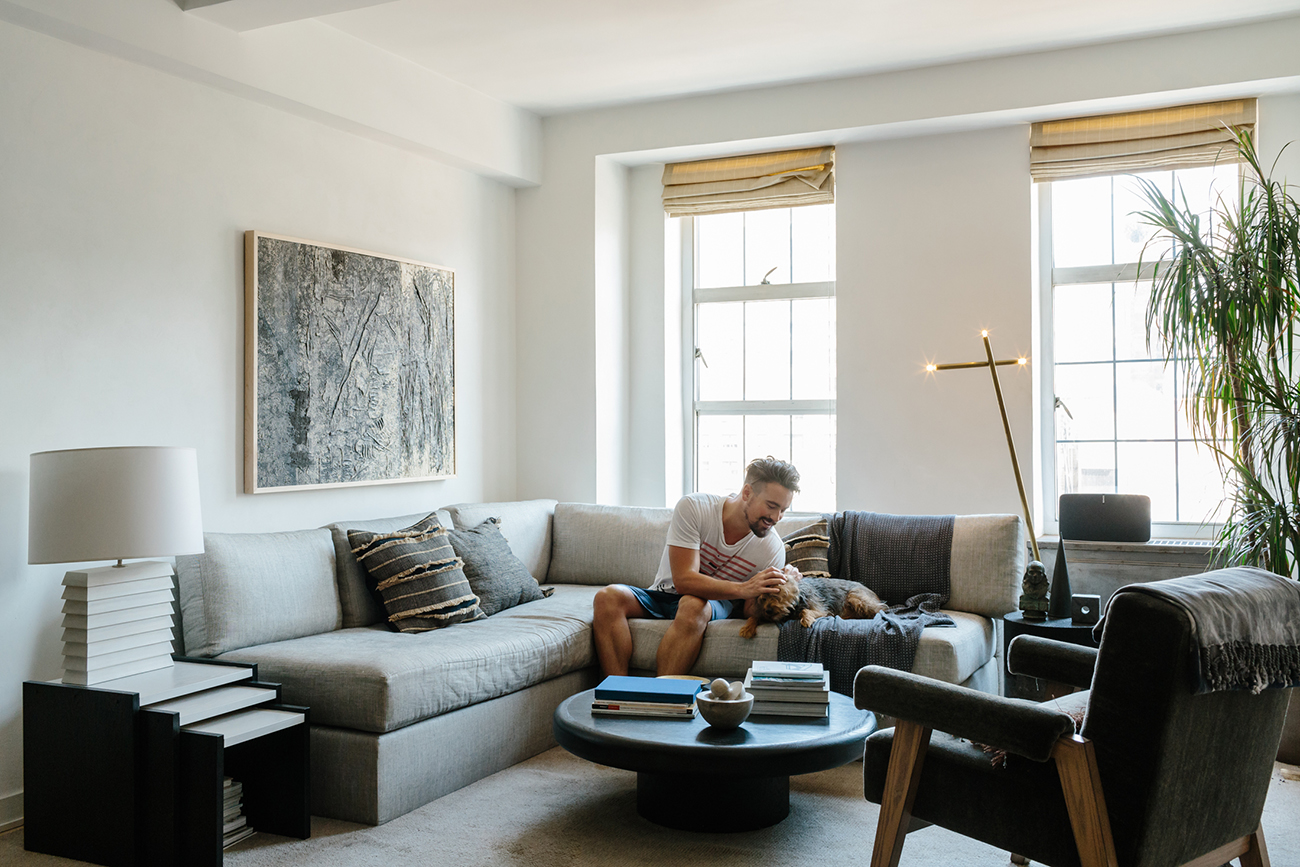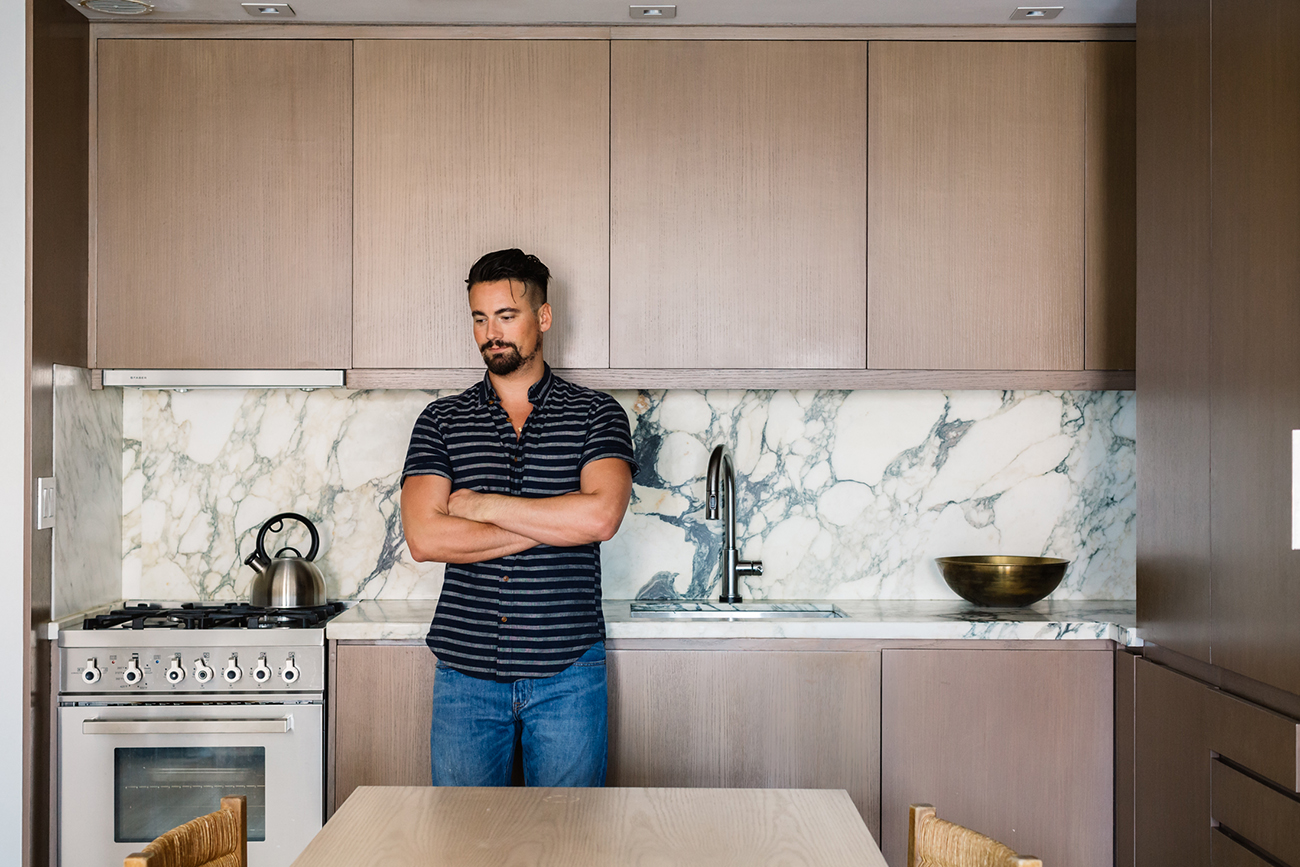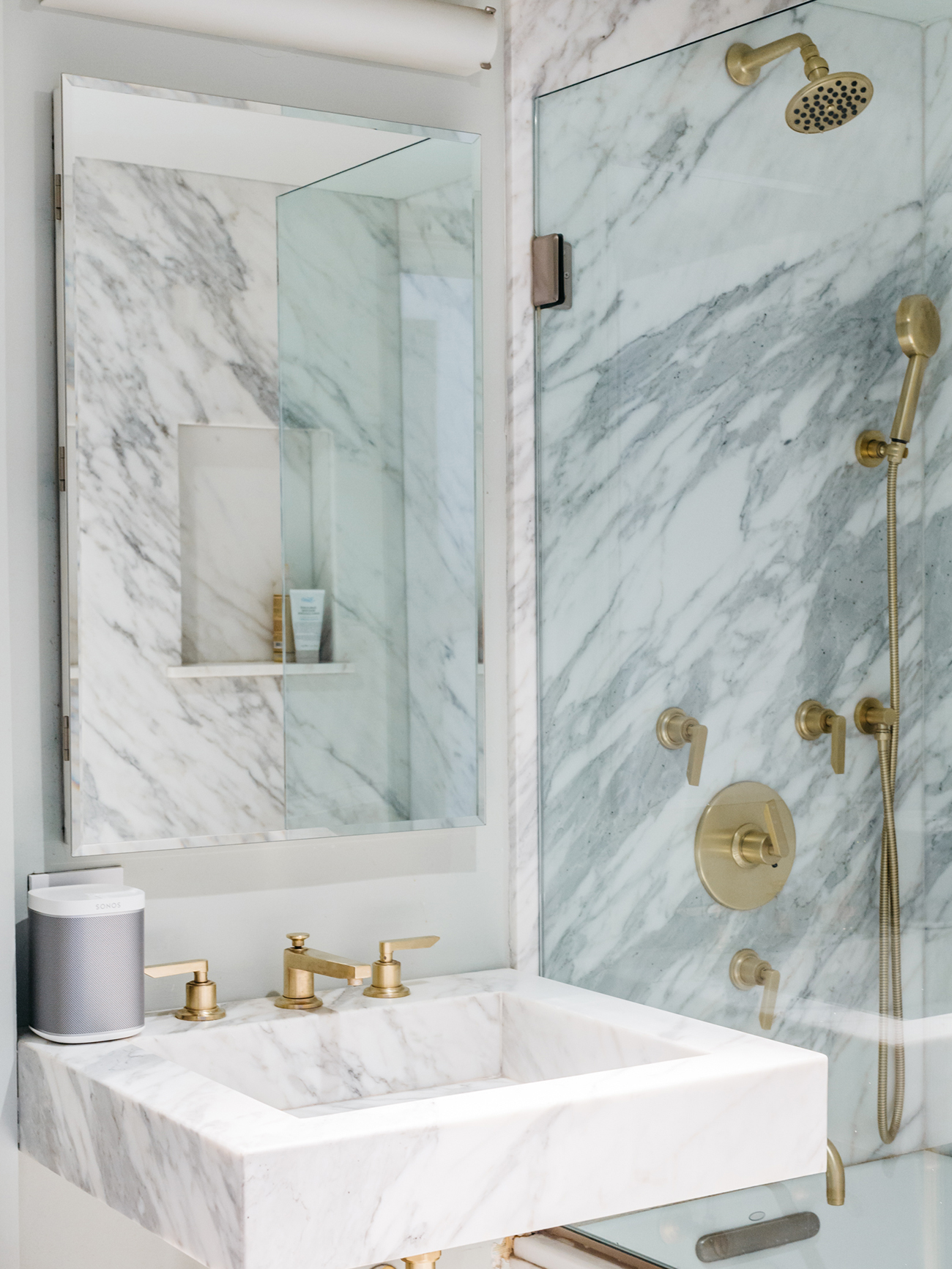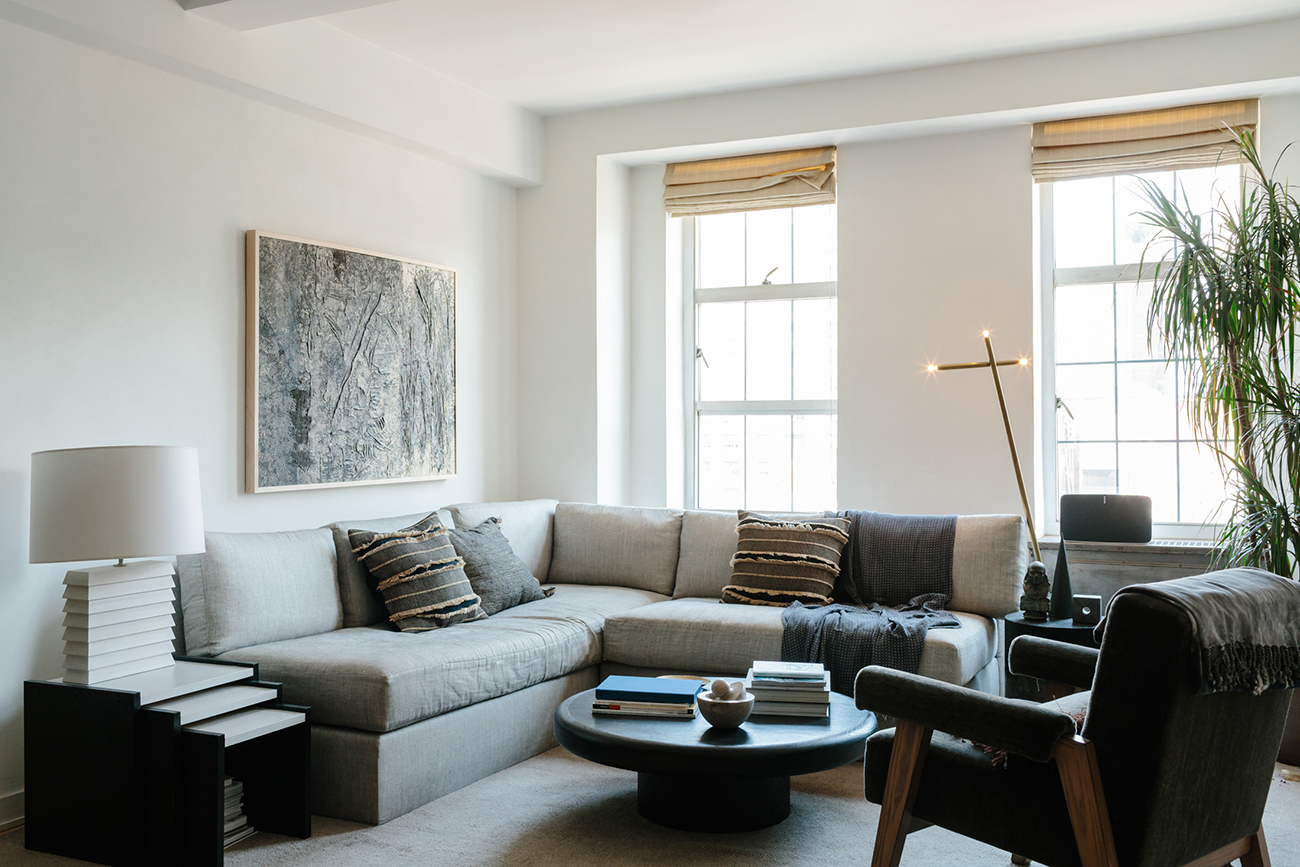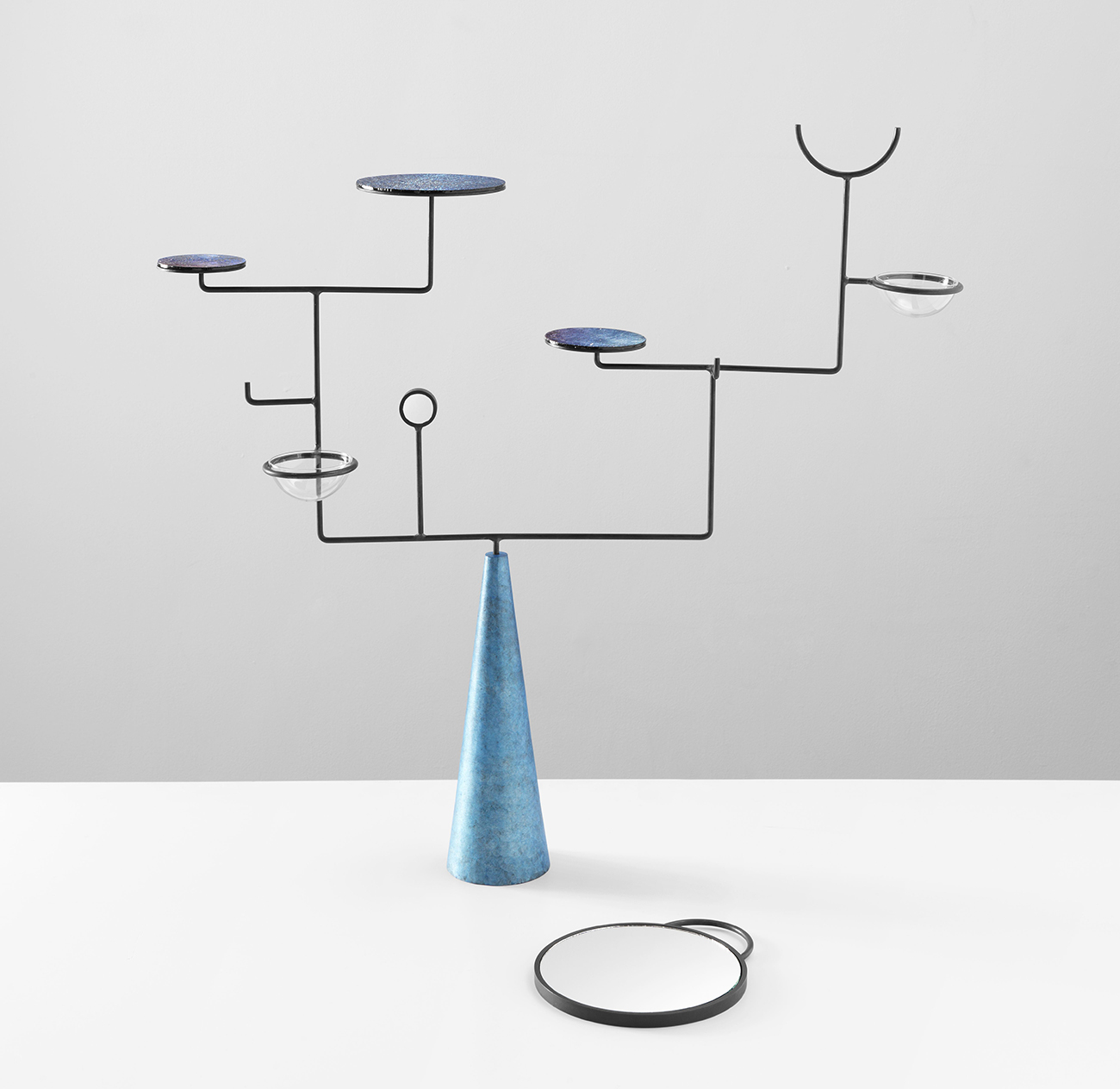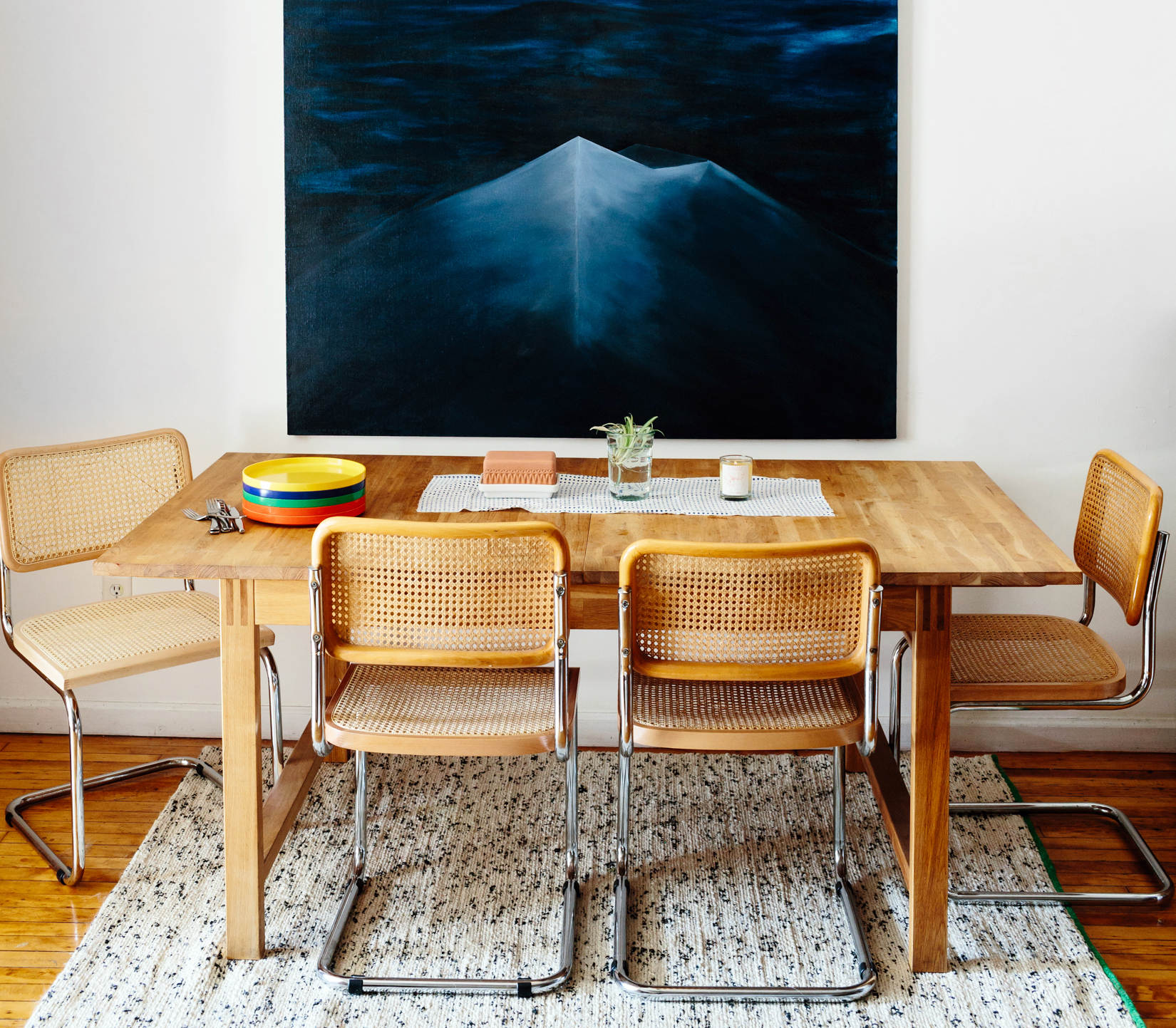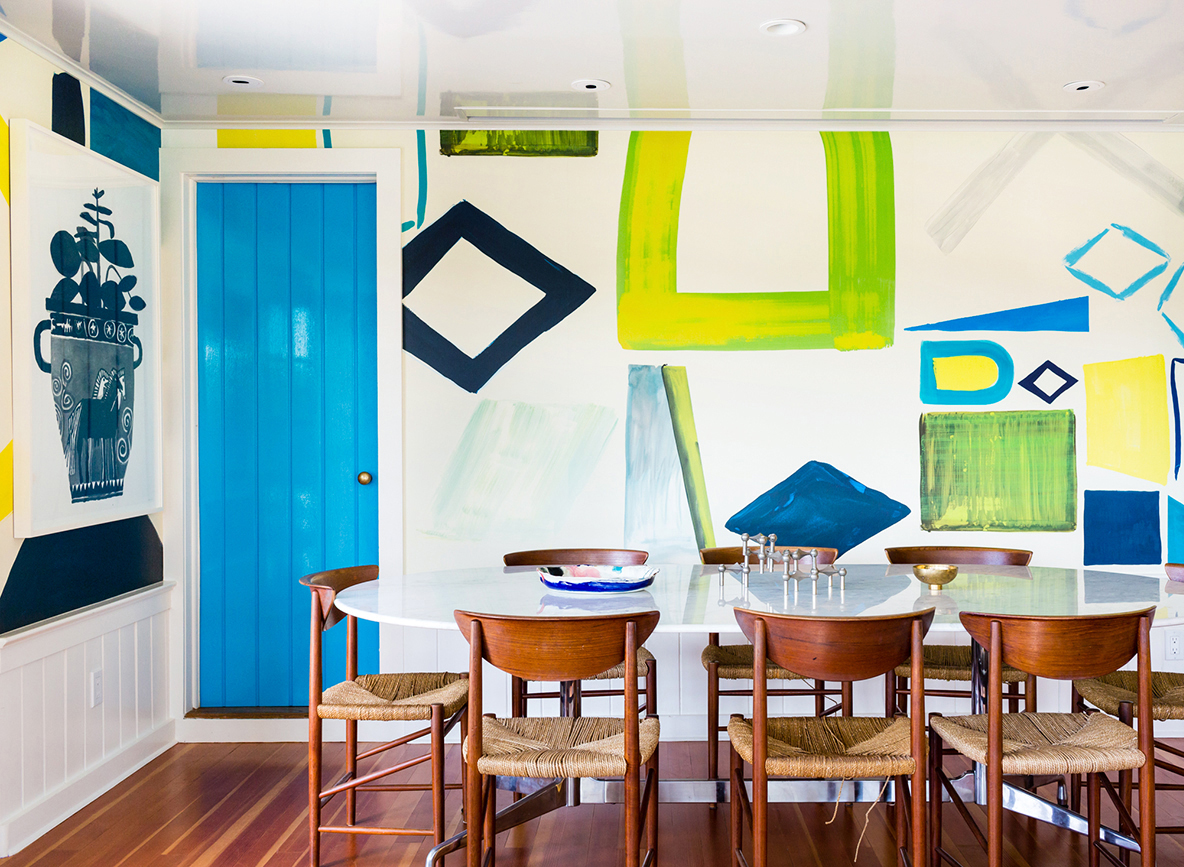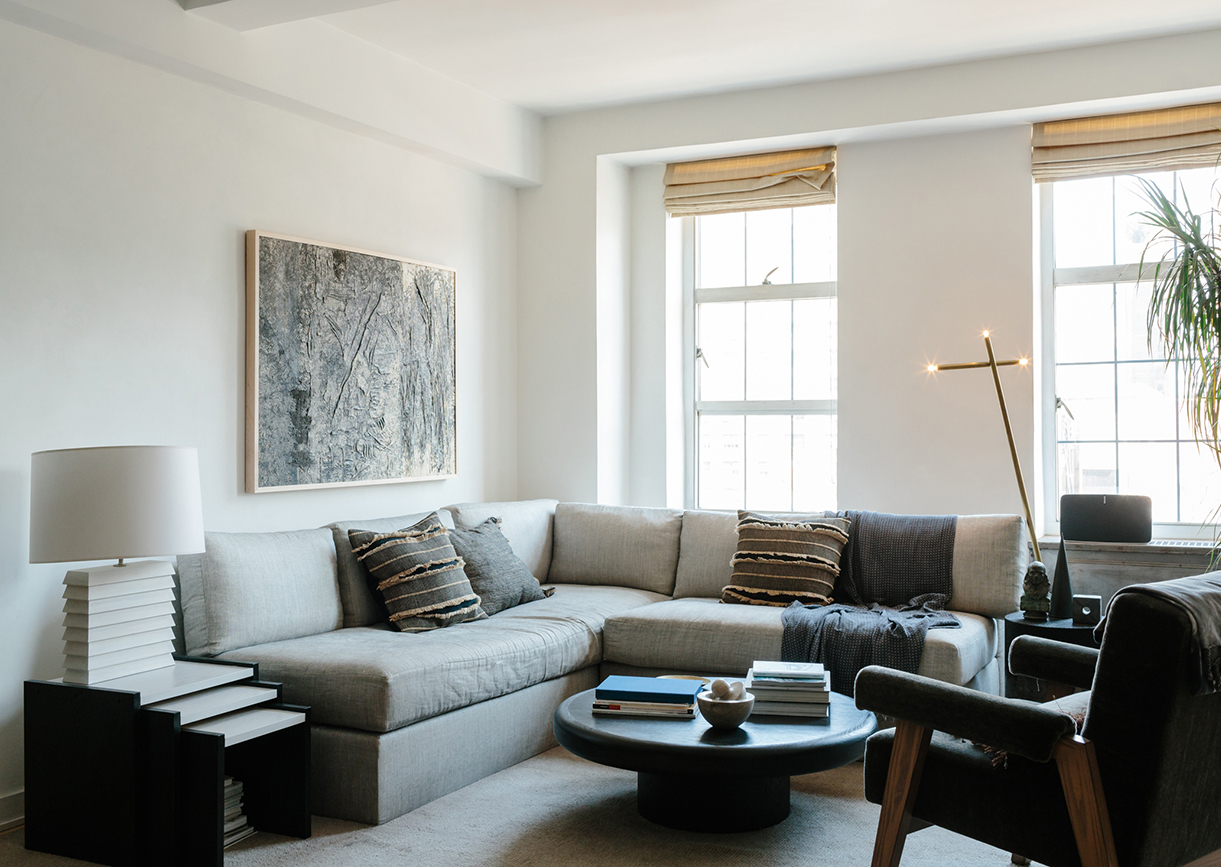
09.06.16
At Home With
Inside the Zen-like Space of One of New York’s Top Interior Designers
Walk into any number of chic boutiques in the world — the Calvin Klein flagship on Madison Avenue, Dior in London, Dover Street Market in New York — and you’re bound to see the work of Samuel Amoia, the interior designer–turned–furniture phenom who’s shot to stardom in the last few years making pieces that mix high and low materials, and incorporate healing minerals and crystals such as amethyst, malachite, pyrite, onyx, and agate. But there’s one place you won’t find many examples of Amoia’s work — in the spare, textural one-bedroom Chelsea apartment he’s shared for five years with his boyfriend, Enrique, and two dogs, Pig and Bruno. “It’s too fancy for me,” Amoia says laughingly of his work, which he makes by hand at a studio in Brooklyn with two of his brothers. Aside from the first drum stool he ever made — a mix of black Indian tourmaline and plaster — and a wooden screen and lamps from his Belize-inspired line Itz’ana Home, the space is filled with curios from his travels and custom furniture — more a showcase for his interior design skills than a showpiece for the work that’s catapulted him to fame.
Amoia spent time working in both nightlife and modeling, but his interior design sense isn’t as brash as those professions could have led him to be. In fact, his most formative gig was as a protégé of famed New York designer Stephen Sills, from whom he learned both a sense of restraint and a deep respect for history, details, and process. We recently spent a morning with Amoia at his apartment for our series with SONOS on the homes of New York’s most fascinating creatives, talking about the allure of ’90s-era Miami Beach, the psychology of interior design, and monastic living in the middle of Manhattan.
PHOTOS BY BRIAN W. FERRY
Your building, London Terrace, is such an iconic prewar New York construction. What was the apartment like when you got here?
We saw this apartment five years ago and loved it. The apartment needed work, but it had great charm and details. We tried to keep a lot of the classic prewar details — the bookshelf niche, the flooring, the medicine cabinet in the bathroom. We stripped the trims, the frames, the doors, and the radiator grilles down to their original zinc finishes, which was not easy.
I needed a space that was calming and soothing — which my work often is — but I wanted a place where I could have clarity in my thoughts and was rejuvenating and just easy. I did this plaster on the wall, because the apartment gets a lot of light early in the morning, and then that’s it. The plaster reflects and adds a nice depth of shadows, so we did a lot with shadow play. The apartment is obviously very monochromatic — the color scheme of the floors and the walls and the furniture. And things are kind of simple. I actually prefer to live pretty monastically; I don’t like a lot of stuff. We cook a lot, and we often have people over for dinner, so we wanted an open kitchen and a big dining room table where I could sit in the morning on my computer, or lay out a Thanksgiving spread. We’ve never actually eaten at this table, but if we have people over, we move all the chairs, we turn the table the other way, and we convene on that side.
With the kitchen, I was obsessed with this stone. It’s an Italian Paonazzetto marble, and I loved it. I pulled some of the colors in the apartment from here — there are these beautiful greens and taupes and burgundies, so the chair in the bedroom was pulled from here. This sort of faded green thing with the gray cement at the bar, I pulled that from here. The kitchen was supposed to be the most poppy, visual part of the space.
Do you think your clients come to you explicitly for that very chic, pared-down look?
I think clients come to me because I make it about them and what they want and how they want to live. It’s kind of a mind game. I often say this business is all psychology — you have to figure out who they are. I’m not one of those designers who constantly does the same look over and over. Every project is different. Most of the projects I do no one even sees, because I don’t photograph them. They’re not published. They’re for a private client, and that’s it. So, I really make it about them. My job is to customize their dreams.
I also think my personal space is pretty friendly looking. It’s not too extreme in any way, so I’ll sometimes have my clients here. They might not want a place that looks like this, but they’ll say, ‘I like what you do with texture, or light, or blending different things together,’ and they can relate.
Tell me about some of the pieces in the house. Do you tend to collect things on your travels?
Yes, totally. The lamp in the living room is by Billy Cotton, and the sconce in the bedroom is by Atelier de Troupe. The arc bench is from my buddies at ASH NYC. It’s is one of my favorite pieces, because it’s so functional to move around and to use, and it’s very sculptural. The zinc sculptures I got in Paris with Stephen Sills when I worked with him. This ball thing I got on the side of the road from a guy upstate who was selling random belongings. It’s just, I think, a weight? It’s what inspired me to make the lamp in the bedroom. I just kind of played off the proportions and made a big ball lamp with a wooden base. But I love it. I have no idea what it is.
That big mirror in the bedroom must do a good job of reflecting the light, too.
It’s funny, I’ve gotten this mirror in so many colors for different clients. I’ve done it in green, blue, light blue, navy blue, orange, green. It’s from a company called Color & Mirror. It’s not that expensive — I want to say it’s like $800 or something like that. I think they’re based in Detroit.
I love those generic supplier names.
Very what-you-see-is-what-you-get.
Speaking of texture, you have these super textural art pieces all around the apartment. What’s the story behind those?
Those are from an artist, her name is Alex Fidelli, and she’s the girlfriend of one of my best friends, but she actually works for us in the studio. Before she was working for us, she was doing these natural material things on canvas, using gypsum and sand and all sorts of stuff. I really like them, because they also resemble my pieces in a way.
You don’t live with very many of your own pieces, do you?
I sometimes do.
Do you test-drive them?
Yeah. I have one drum, a black one — that was actually my first piece — but other than that, I feel like, especially with the new stuff, it’s too fancy for me. I mean it’s durable, and it’s strong, but what would I do with it here? But we’re going to sell this place and get a townhouse somewhere and there I’ll have more space. I’m also doing new stuff with resin, which is really cool. It’s very similar to the Amoia Studio shapes — drums, consoles, side tables. It’s a thick, cast resin where we’ve sprinkled and layered in materials such as bronze, copper, brass, and aluminum shavings.
Those are the same materials you used in the Delorenzo collection. Is every collection you create an evolution of the last one?
Sort of. I mean it’s always materials-based, and I always do very similar forms. I always say I try to do the most and the least, so I like to use one or two materials max, simple shapes, simple forms. The language and the narrative is always the same. Like resin, we have used it, but in a different way — to bind stuff. I’ve never used it as the primary material. We actually did it as an accident, and were like oh, this is cool. We showed the kids from Peter Marino, and they were like, “Oh my god, this is amazing. It’s very Dior.” So they were kind of the catalyst for it. What’s cool working with resin is you do it in layers, so you can do maybe a silver leaf foil underneath, and then more resin, then silver flakes. You can also control the patterns, like the way the material drifts through the resin. We’re playing around with everything, and seeing how it works, contextualizing it in the molds. And then, hopefully, lighting. I’ve been trying to think how do to other stuff with the resin, because it’s an easier and cheaper way for us to use stones and materials that might otherwise be too expensive.
Let’s switch gears for a second and talk about what drew you to the design world in the first place. You grew up with four brothers in Buffalo. Was there design in the home?
I grew up in a crazy household, so I used to lock myself in the bathroom, or, when I got my own room, I would lock myself up in there. And as a kid, I did design and create an oasis in my bedroom. It was super cool. It was the early ’90s, and I painted my room this very dark midnight blue — the ceilings and trim, too. My mother wanted to kill me. She still to this day cannot get the blue to go away. And I had this nice, beautiful, almost Scandinavian bleached-wood bed. I created this very calming and soothing environment, which was the opposite of my house.
Was that all your invention, or were you reading design and shelter magazines at the time that influenced you?
It was all me. I just kind of dreamed it up. And then when I moved to Miami, I thought I wanted to be like Ian Schrager, because the Delano was the first place I’d ever been to that kind of rocked my world. I was 14 or 15 years old, so it was a very impressionable time, and to see the dark wood and beautiful flooring, the long white curtains, and the scale of everything — the scale was the most impressive thing. The materials in the space were beautiful, but it was the scale, and then the smells. I was like oh my god, whatever this is, I want to be a part of it.
So I thought I wanted to be an Ian Schrager, and I still kind of do. I started to work for people like Andre Balazs. I thought I wanted to be a hotelier, because I love food, I love cooking. I loved what Schrager did with hospitality and the way people were living in a hotel and sleeping and experiencing it. Even if you’re not staying at the hotel, you’re walking through it, you’re eating there, you’re drinking there. You’re listening to music. It’s such an experience. It never left me. Then, meeting Stephen Sills and seeing what he does and working for him, it was an incredible experience. It brought me to being an interior designer. And designing furniture for clients then turned into being a furniture designer.
What brought you to Miami in the first place?
My uncle was an architect. He lived down there. The allure was amazing.
From Buffalo, I imagine, yeah.
Yeah (laughs). My first visit there was in the early ’90s and I was like, ‘Whoa.’ Miami Beach in the early ’90s was a really cool place. I mean it’s still great, but it was very different then. My uncle built hotels and all the nightclubs in the ’80s and ’90s. And I just loved everything about it. You had all the little old Jewish people that were living there and the old Cubans and then all these models, photographers, producers, and nightlife people. It was much more bohemian back then. I also loved Art Deco, so I was like okay, I’ve got to be here.
Was that when you were working as a model?
I never really called myself a model. I worked with Ford and I had five catalog clients. I never went to Milan. I never went to Asia. I never did runway. Never walked around with my book. I worked for Target, Marshall Fields, Kohl’s. But yeah it was like $5,000 a day at 16 years old for two hours of work. If I worked twice a month — you do the math. So I did that in Miami, and that’s how I was able to move here.
Do you remember the first furniture piece you designed?
My job when I was working with Stephen Sills was going to all the vendors and working with the craftsmen, and I loved being in the workshop. I was really good at having a clear language with them in terms of finishes, especially because Stephen was so particular about that stuff. I learned that language, and I was able to speak with people to really get it right.
The first piece I did was when I was working in Miami. I had this idea to make this thing with stones or rock salt, and I wanted to contrast it with cool, colored cement. I had gone to a lot of vendors and mill workers to do it, and no one was really getting it right. I had a friend who introduced me to Fernando [Mastrangelo], and he was able to hear me and listen to me. So as AMMA, we were able to do these pieces together, and it was obviously great for both of us. From there, I went my direction, and he went in his, and we sort of evolved the language from there.
And you went into business with your brothers. Or is it just one brother right now?
Well, it’s two. Sometimes three. My youngest brother was always very creative. He had just graduated from high school, he went to an art school, and I had him work for me and Fernando. He was really close with one of the guys in our studio; he really showed my brother a lot of stuff, and my brother was always doing things on his own. He was coming up with great ideas, and it was great collaborative back and forth. As the time came, it was like alright, let’s do this. Then, we have another brother who’s an actor. When he’s in between productions and stuff, he helps out and helps us with work, which is great.
What is your next big project?
I actually signed with CAA four months ago. We put together a TV concept, which is going to be a show about my interior design stuff, probably mostly focusing on a hotel we’re working on in Belize, because we’re doing so much custom stuff with local artisans and things like that. And then the studio work with my brothers. So, depending on which network we go with, it might go a little left, it might go a little right. We have three networks really interested in it, and we’ll see what happens. It’s what they call an “occu-docu” series — an occupational documentary. But obviously, if it goes to Bravo, it’s going to be more focused on my brothers and me and the jet-setting. If it goes to like Esquire or HGTV, it will be probably a little bit more process-oriented.
Is there something you’ve always wanted to design that you haven’t yet?
Like an object? I don’t think so.
That’s good, that means you’ve had a fulfilling career so far!
Yeah, I mean, I didn’t go to school. I didn’t study design. I have no business to be in this business, but somehow, I’m here. I’m doing okay. I think it’s evolving. I have an urge to go back to hospitality, and as I said, I’m designing a big hotel in Belize — we’re doing everything from branding stuff and changing logos to thinking about smells and what kind of food the guests will eat, and how’s it going to be served? It’s a very lifestyle driven thing. It’s definitely sparked a fire in me where I’m like I kind of want to get into that again. Who knows? I might just open a hotel in the next couple of years.
Click on the player above to listen to the SONOS Listening Room podcast, hosted by Jonah Bayer, where Sam reveals his personal soundtrack to New York City. Then visit SONOS’ first-ever flagship at 101 Greene Street in New York for the full SONOS listening experience.
The fourth in our series on the homes of New York City creatives, this post was sponsored by SONOS, but all thoughts and editorial content are our own. Like everything at Sight Unseen, our partner content is carefully curated to make sure it’s of the utmost relevance to our readers.
